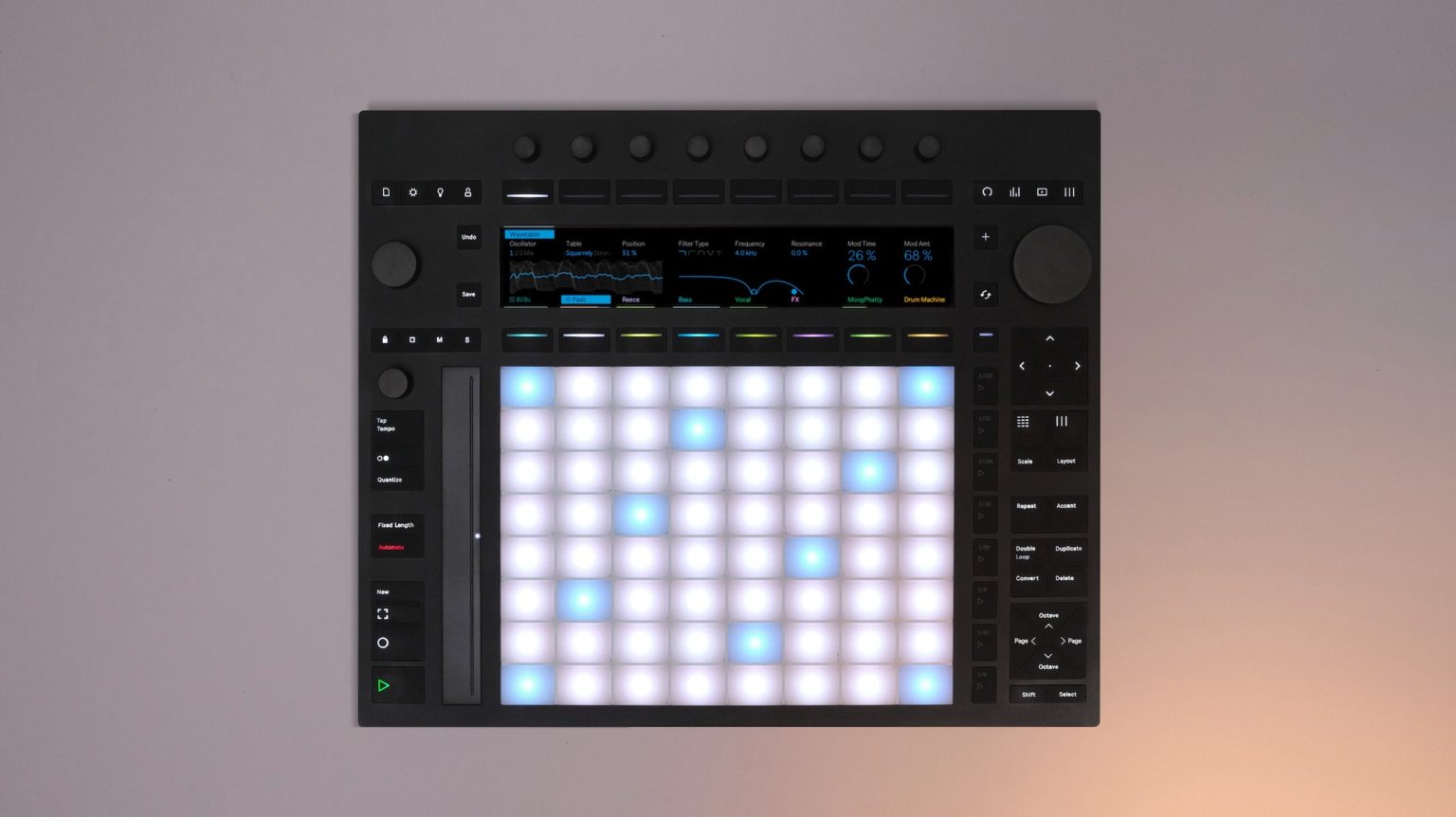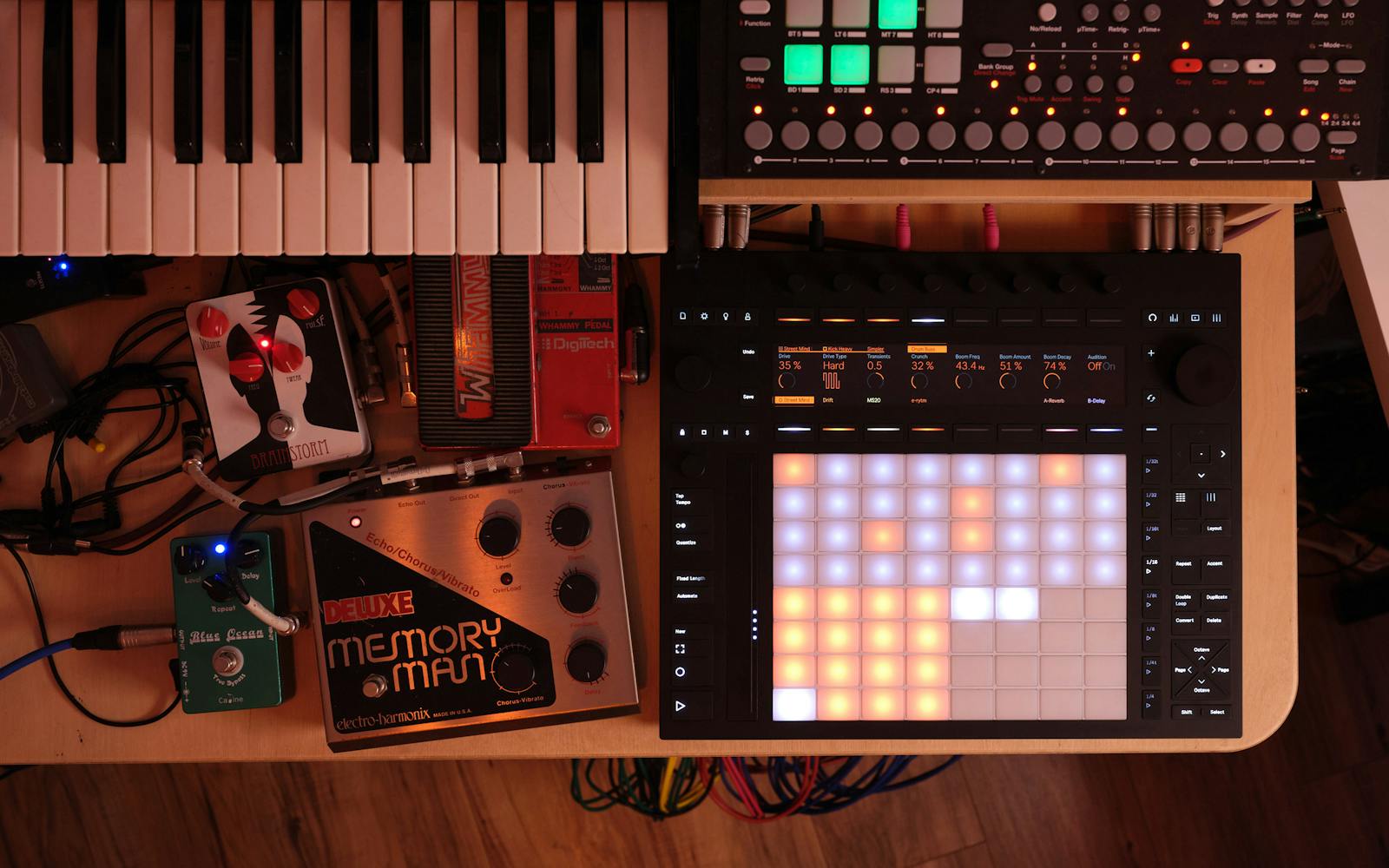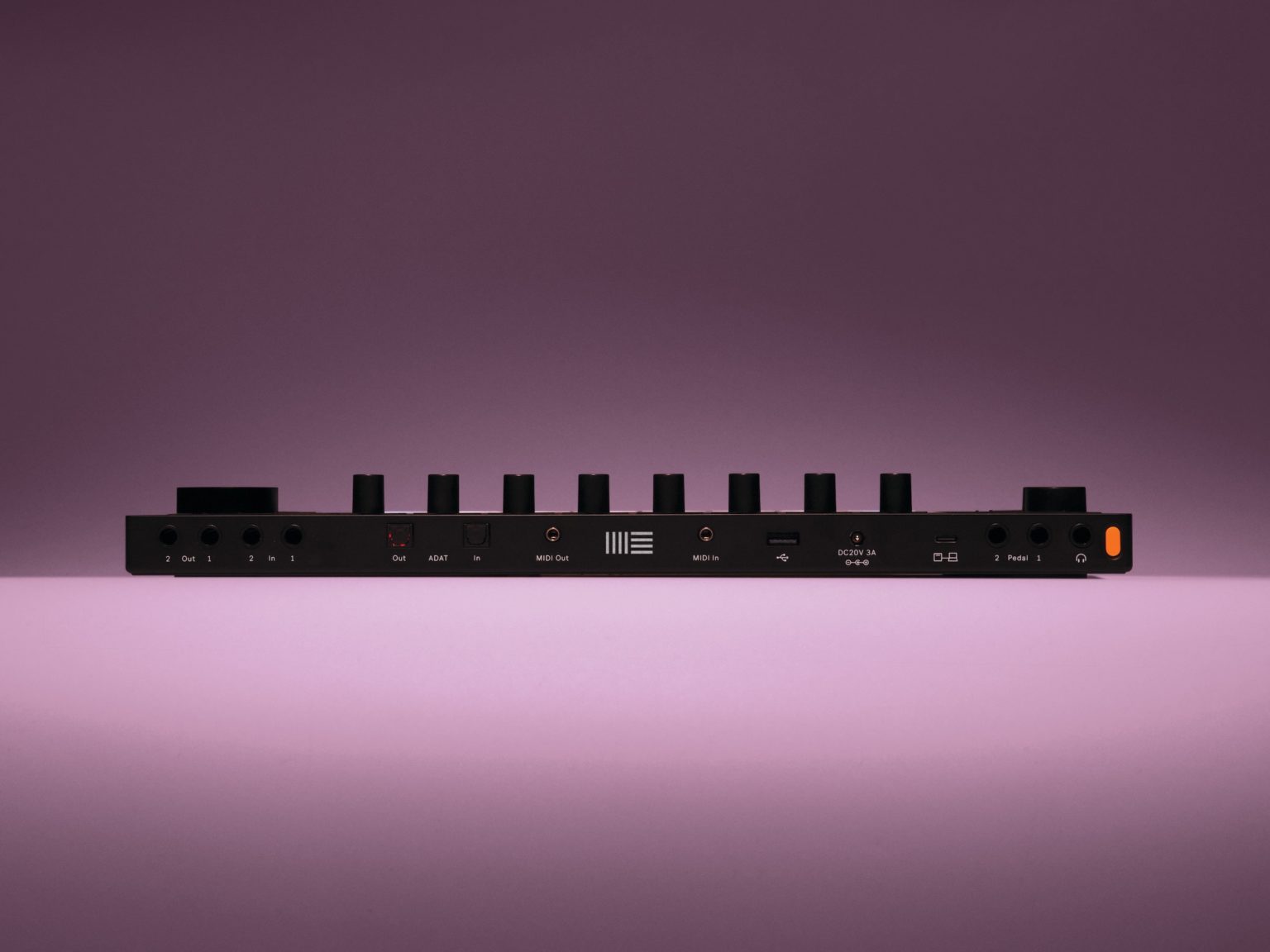Ableton Announces Push 3
Posted by James Cullen on
Hardware controllers are always an amazing part of a producer's set up, and things are even better when your controller is perfectly integrated with the software you're using. Ableton have always been known for collaborating with other companies on creating. this kind of dedicated hardware integration on devices like the Novation Launchkey range.
However, it's Ableton's newest dedicated hardware controller that we will be discussing today, because after much anticipation, it's finally here.
That's right, Ableton has officially announced the launch of Push 3, the third generation of their Push hardware, and it looks incredible!
While there's definitely familiarity in the design, (if it ain't broke, don't fix it) there are a ton of new features in the hardware, as well as a couple of different editions - more on this later
So, let's dig in to everything we know about Ableton Push 3!
Thinking outside the box
A legitimate criticism of the older Push models was how the workflow wasn't as smooth as it could be, specifically when editing clips, because there was a lot of looking up at the computer screen and back down to Push. This kind of break in your workflow can really put a block in how efficiently you get your music made, but Ableton have addressed this in a number of ways.
The most obvious one is the also one of the most exciting things about the new Push 3. It comes in two editions, one of which is a standard MIDI controller, while the other is able to be used as a standalone instrument running Live, with no need for a computer.

This is the most exciting new feature and it bears repeating; you can use Push 3 without a computer.
It has Live's internal instruments, Audio Effects, MIDI effects and all of the usual functionality you'd expect from the DAW built in, meaning you can create beats on Push without ever needing to turn on your computer.
What's more, is that you can seamlessly transfer your projects from Push to Live, and vice versa. However there's a caveat with the second option, when moving things from Live to Push 3.
This is because there's no official support for third-party plugins, meaning you'll only be able to use official Ableton devices on the Push 3, so any projects you're making in Live itself that you want to transfer over will have to be free of third-party devices.
Having said this, perhaps third-party support will be something that's introduced in the future. Only time will tell!
So, on that note, we need to talk about the two different editions of Push 3.
Standalone Edition
The standalone edition is obviously the shiny new toy when it comes to the two editions of Push 3, coming in at a whopping £1669, but for that price here's what you get.
- 64 MPE enabled expressive pads
- Built-in audio interface
- Intel 11th Gen Core i3-1115G4 processor with 8GB of RAM
- Built-in Lithium battery with up to 2.5 hours of play time
- Built in 256GB SSD hard drive
- Ability to upgrade and replace hardware when new parts are available
This is fantastic in and of itself; the ability to use Push 3 as a standalone instrument offers a whole new range of possibilities for both making and performing music with Ableton, but it's the last feature that gets me most excited.
With Push 3, you can replace the processor, battery and hard drive down the line as the technology improves.
This is obviously great for sustainability; you won't need to throw away old hardware once new capabilities become available. It also means you should get a longer life out of your Push 3, and keep up with the ever increasing processing and computing power we enjoy today.
It also means your hardware won't become outdated compared to the software. Software updates with new features for Live will be able to be included in Push 3, and the hardware updates will make your controller keep pace.
Controller Edition
The controller edition of Push 3 is available for £879, and serves as the traditional MIDI controller device for Ableton Live. The only difference here is that it lacks the processor, battery or SSD. However....

You can also upgrade this version, and at basically half the price of the standalone, it gives you the opportunity to try it out before you commit to a more pricey purchase.
So, if down the line you decide you want to be able to use it as a standalone model, you can purchase an Upgrade Kit for £879, which contains the processor, hard drive, battery and heatsink, as well as all the tools needed for the assembly.
These are obviously both super exciting, but it's just the tip of the iceberg.
Let's have a look at what Push 3 can really do.
Push 3
Ableton's position on Push 3 seems centered around them wanting this device to "be at the heart of your setup for years to come".
We see that in the focus on upgradeability and the standalone working mode, but what new features are present to help us get the most out of this new device, and more importantly, to make us want to keep it as the focus for years to come?

One of the biggest and most notable of these new features is Push 3's focus on giving you indepence from your computer, regardless of whether you're using it as a standalone or controller.
The intention since the first model came out has always been allowing the user to make music in the familiar Ableton formula but in a way that feels intuitive and flows nicely, eliminating the need to ever touch your computer. But this hasn't always been the case in practice, as many people have found they need to keep looking up at the computer, which can be quite jarring for your workflow.
However, users of Push 3 will find themselves wanting to make music in it without having the hassle of reaching for their computer. While previous editions definitely added to the experience of making music, there often wasn't anything lost if you didn't have it on.
Push 3, on the other hand, is so intuitive and easy to use that it will become your default way of making music using the Ableton framework.
A super exciting feature is that Push 3 now comes with some audio I/O, meaning you can use it to record external audio.
Regardless of whether you get the standalone version or the controller version, you'll be able to record audio into your Live Sessions.
Analog audio is two in, two out on 6.35mm (1/4″) jack plugs.
But there’s also ADAT I/O, which gives you multichannel digital audio – ideal for use with digital mixers and other gear.
This is a really great feature that helps you see how Push 3 could become the creative hub of your studio, not only allowing you to work with MIDI and Audio samples within Live, but also with recorded instruments, vocals, turntables and more!
Physical Design
In terms of the actual unit itself, Ableton haven't had to change the hardware layout much, other than the pad grid, which we will get to soon. This means that existing users will be familiar with the hardware within a relatively short time of getting hold of it.
There have been numerous minor refinements across the board, but here are the main ones.
Overall, it's easier to navigate Push thanks to the likes of the new large wheel on the right hand side. This has rocker settings which make navigating through the Browser intuitive and simple.
You also have three new encoders, giving you dedicated control for tempo and main output.
There have also been some welcome changes which address some of the biggest issues of previous hardware. You have a dedicated Capture button, meaning you can save what you're doing directly into a Clip.
Most exciting, is the fact that Clip editing is now almost as easy on the hardware as it is on a laptop screen, meaning you can get some really precise and humanised grooves going without having to rely on your computer to edit those finer granular details!
The LCD screen is also beautifully rendered, offering more detailed views in a better resolution.

New Pads
While the fact that Push 3 now comes in two editions is an exciting prospect, the other main feature of the new unit is a completely re-designed expressive 8×8 pad grid, which now supports MIDI Polyphonic Expression (MPE).
The grid has been redesigned completely. It's now all white, and the vertical profile of the pads and the size of the gaps between them have been reduced, meaning you can easily slide between them. And you'll be doing lots of sliding.
Each individual pad is not only pressure sensitive, but sensitive to hits and gestures on X and Y. This means that the output you hear changes depending not only on how hard you press the pad, but also where you hit it.
You can wiggle your finger to add vibrato, slide it around to add additional control, or configure each pad on X and Y to respond to hits on different parts of the pad for variations in pitch and timbre.
These pads respond to the slightest movements of your finger tips, allowing you to bend, slide and shift between different notes, sounds and articulations with ease. Seeing some of the videos of performances on Push 3, you can already see how well this feature is included, and imagine how you can use it in your own productions.
You can perform your music in a number of different ways, with your sounds evolving and changing based on how your fingers move on each pad. It's a really fantastic addition to Push's hardware, and will be inspiring musicians to get super creative with their sound design!
This all means you can play note bends, crazy theremin-style synths or lush shifting chords. You can vary the tone and timbre of your sounds without ever having to take your fingers off the pads. The amount of range here is fantastic!
It's a fantastic new feature, and I can't wait to see how it's used by the community once Push 3 has made its way into different performers' setups!
One of my favourite features of these new pads is how you can work with drums; you have timbral variation which mimics a real drum head, so you can get different velocities based on how you play. You can even take this one step further by adding different percussive articulations based on different input gestures.
Hit a pad one way, it's a single closed hi hat, subtly change the way you press it, and it becomes a hi hat roll. And so on!
The possibilities for this are endless!

A studio staple
Push 3 looks fantastic, and the features it's loaded with match this quality completely.
While it's the heaviest of the Push controllers, coming in at 3.95kg / 8.7lbs, this doesn't detract from its use as both a studio and live performance instrument.
The ability to connect it to other gear really allows you to see how it will quickly become the central port of your studio, where your other gear is running through it and you're using it as a creative hub to write your music. This includes CV / Gate, meaning you can control and sequence your modular setup and o her external synths by sending CV and gate signals from Push's footswitch jacks.
What's especially exciting is the ability to seamlessly transfer your Ableton projects from Push 3 to Live over WiFi, and as we mentioned, providing you only use Live native devices on your computer, you can transfer your projects back to Push 3 for live performance or further work.
I'm super excited to see how Push 3 is integrated into performers studios over the coming months, and I anticipate some really exciting ongoing support for it over its lifetime. The Upgrade Kit will be coming out towards the end of this year, so folks who buy the controller edition and want to upgrade to standalone won't have to wait too long.
What do you think of Push 3?
Will you be picking one up?
Let us know down in the comments, and as always, thanks for checking in with us here at Top Music Arts.
While you're here, why not check out our deals on Ableton Live Project Remakes? These are a great way to learn how a professional track is built from the ground up. We have a dedicated team of producers working to bring you faithful recreations of professional tracks in a wide range of genres, and these are incredible learning resources, so check them out before you go!